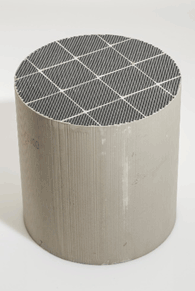
Silicon carbide (SiC) in “spent” emission control catalysts recycle streams requires more time and energy to process in electric arc furnace (EAFs) than the typical cordierite ceramic material. This means that SiC material must be separated...

Silicon carbide (SiC) in “spent” emission control catalysts recycle streams requires more time and energy to process in electric arc furnace (EAFs) than the typical cordierite ceramic material, according to BASF Corp., Florham Park, New Jersey. This means that SiC material must be separated from cordierite material and processed separately. Otherwise, recyclers incur additional costs from the longer processing time and increased energy use, the company says.

SiC filter substrates can be identified by their dark gray color compared with the typical light brown color of cordierite filter substrates. Additionally, SiC filters usually consist of sections that have been glued together, while cordierite filters are a single piece.
According to the company, separating the SiC catalysts before further processing reduces the amount of lots that have SiC, so more material can be run at normal rates. Lots that are comprised solely of SiC can be run at reduced rates. This maximizes efficiency and minimizes any additional costs.
To reduce pollution, legislators worldwide are setting ambitious objectives for the automotive industry. To meet these objectives, state-of-the-art technology that combines the catalyzing power of PGMs (platinum group metals) and new materials such as SiC is being used. These materials can still be recycled but must be separated from standard cordierite material because they require more time and energy to process, BASF says, otherwise the industry will not be able to continue the sustainable and efficient recovery of PGMs.